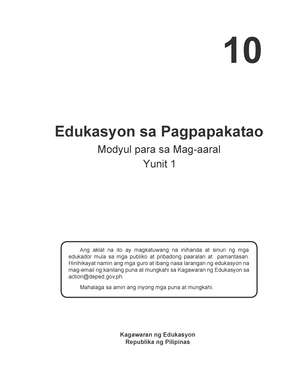- Information
- AI Chat
Was this document helpful?
Sources of History: Primary, Secondary and Tertiary
Course: BSED- Filipino
461 Documents
Students shared 461 documents in this course
University: Bohol Island State University
Was this document helpful?

Lesson Outcomes::
Discussed the difference between primary and secondary resources; and
Enumerated some examples of primary and secondary resources;
Analysed the distinction of given sample sources.
Introduction:
Most historical source materials can be grouped into four basic categories:
1. Documents – are written or printed materials that have been produced in one form or
another sometime in the past.
2. Oral Statements include any form of a statement made orally by someone.
3. Relics are any objects whose physical or visual characteristics can provide some
information about the past.
The main emphasis in historical research is on the interpretation of documents, diaries, and
the like. Historical data are categorized into primary and secondary sources.
A Primary source is one prepared by an individual who was a direct witness to the event
that is being described. It includes first-hand information, such as eyewitness reports and
original documents.
A Secondary source is a document prepared by an individual who was not a direct witness
to an event, but who obtained his description of the event from someone else. It includes
secondhand information such as a description of an event by someone other than an
eyewitness, or a textbook author’s explanation of an event or theory.
Analysis:
Abstraction
A. The distinction of Primary, Secondary and Tertiary Sources
Sources were labeled as primary, secondary, and tertiary for them to distinguished easily and
identify the authenticity of the sources.
Primary Sources
Primary sources give first-hand and original information. Examples are eyewitness accounts,
personal journal interviews. A person who has seen the actual event can be considered as a
primary source.
Types of Primary Sources
1. Autobiographies and Memoirs
An autobiography is an account of a person’s life written by that person.
A memoir is a history or record composed from personal observation and experience.
2. Diaries, Personal Letters, and Correspondence
A diary, a form of autobiographical writing, is a regularly kept record of the diarist's activity
and reflections. Diary is written primarily for the writer's use alone; the diary has a frankness,
unlike writing done for publication.
A personal letter is a type of message (or informal composition) that usually concerns
personal matters (rather than professional concerns) and is sent from one individual to another.
A correspondence is a body of letters or communications. If you've ever had a pen pal or
an email buddy, you've written plenty of mail.
3. Interviews, Surveys, and Fieldwork
An interview is a conversation where questions are asked, and answers are given.
Unit 1:Meaning and Relevance of History
Lesson 2 Sources of History
Think about the history of a barangay or municipality where you lived.
How did you get the information you get?
Were the sources reliable?
Are there pieces of evidence presented?












